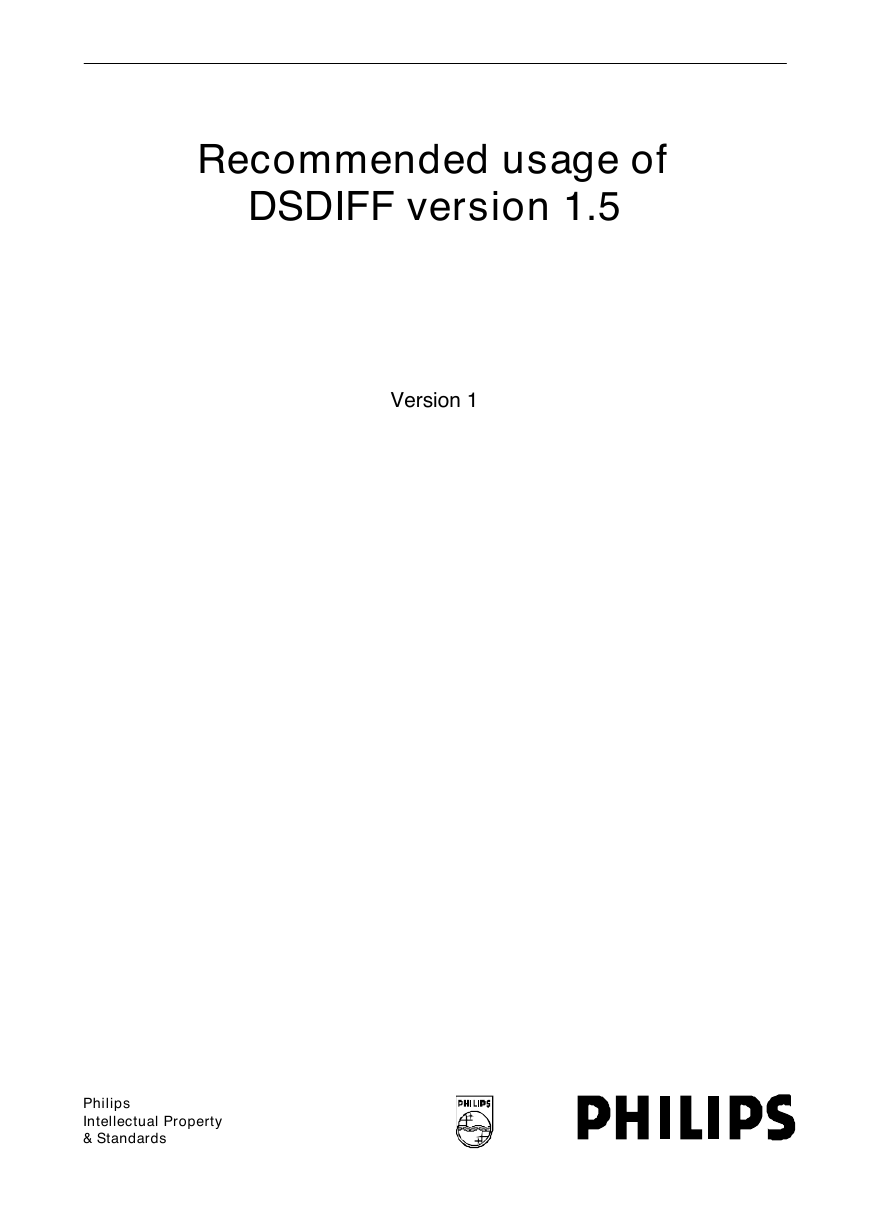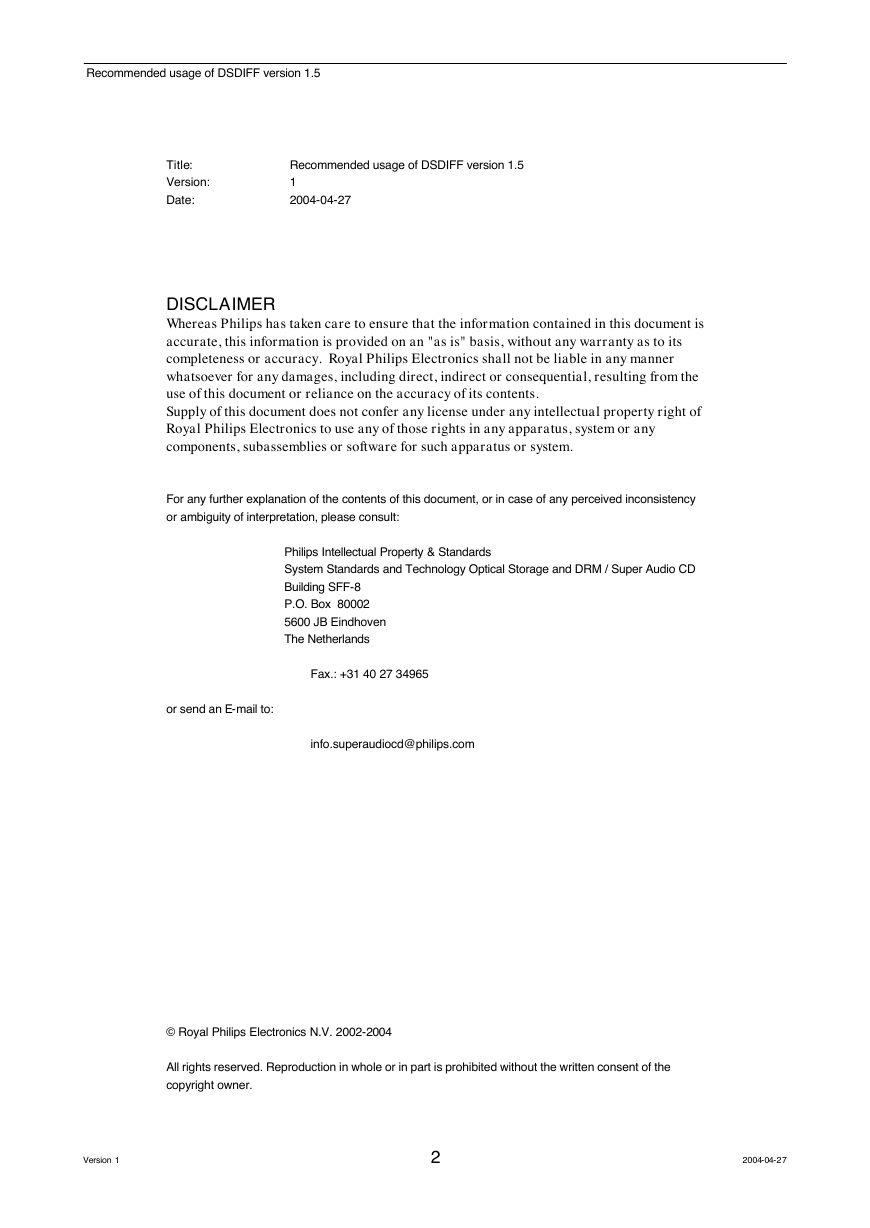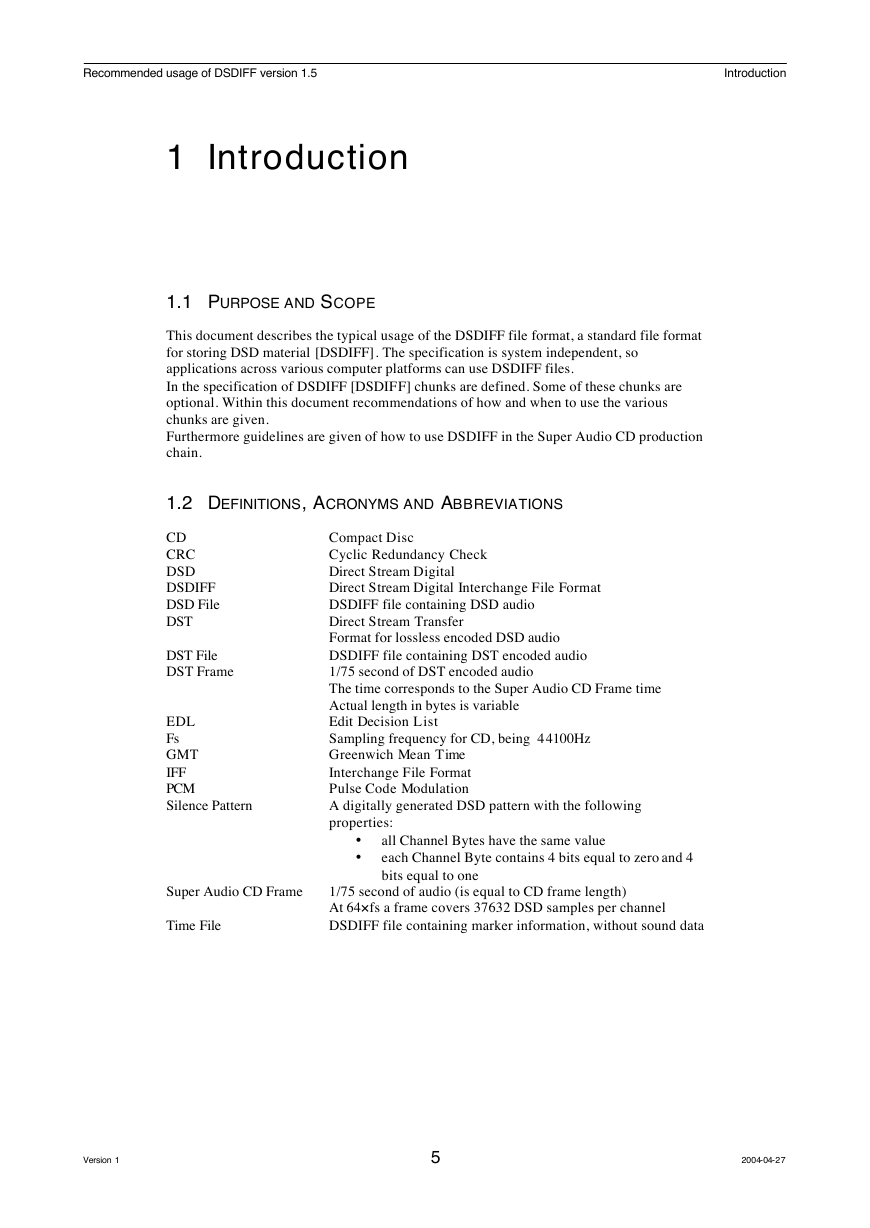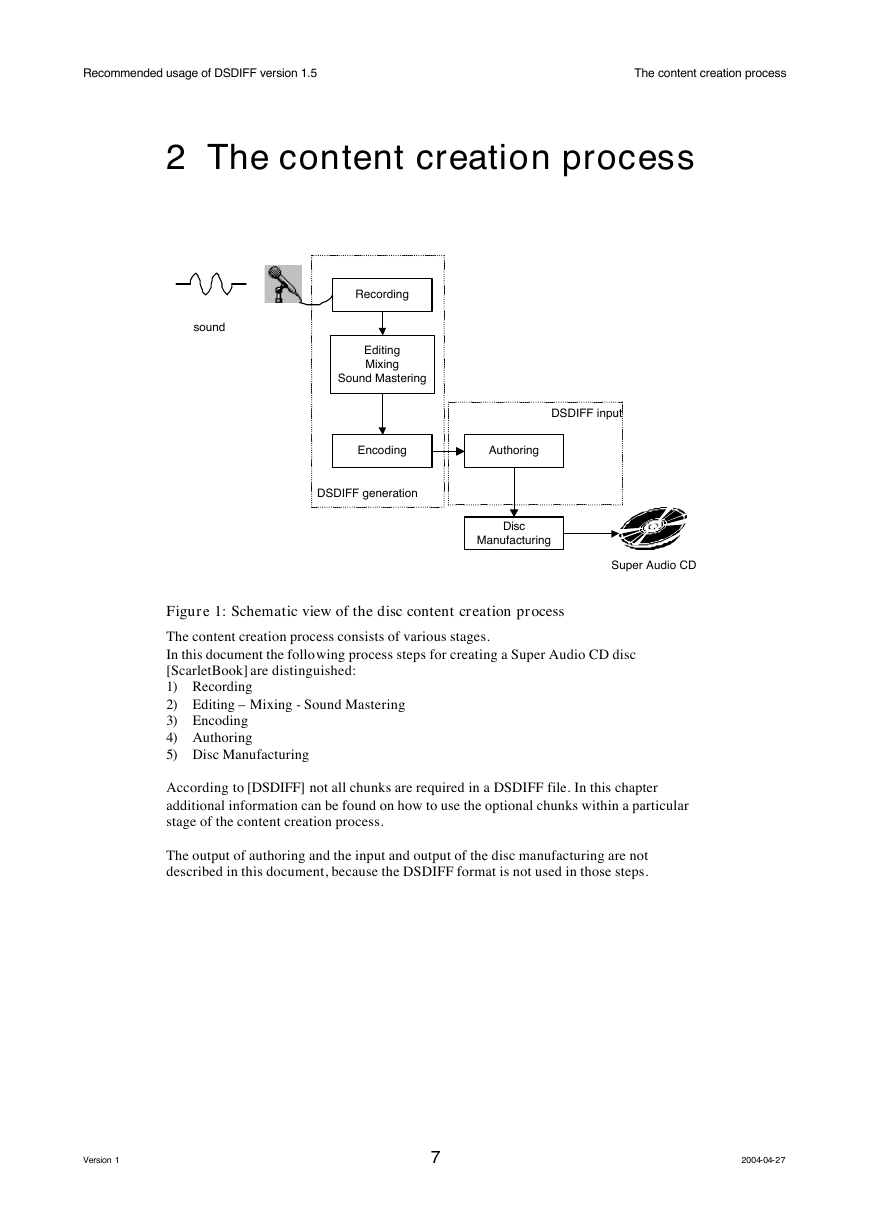Recommended usage of
DSDIFF version 1.5
Version 1
Philips
Intellectual Property
& Standards
�
Recommended usage of DSDIFF version 1.5
Recommended usage of DSDIFF version 1.5
1
2004-04-27
Title:
Version:
Date:
DISCLAIMER
Whereas Philips has taken care to ensure that the information contained in this document is
accurate, this information is provided on an "as is" basis, without any warranty as to its
completeness or accuracy. Royal Philips Electronics shall not be liable in any manner
whatsoever for any damages, including direct, indirect or consequential, resulting from the
use of this document or reliance on the accuracy of its contents.
Supply of this document does not confer any license under any intellectual property right of
Royal Philips Electronics to use any of those rights in any apparatus, system or any
components, subassemblies or software for such apparatus or system.
For any further explanation of the contents of this document, or in case of any perceived inconsistency
or ambiguity of interpretation, please consult:
or send an E-mail to:
Philips Intellectual Property & Standards
System Standards and Technology Optical Storage and DRM / Super Audio CD
Building SFF-8
P.O. Box 80002
5600 JB Eindhoven
The Netherlands
Fax.: +31 40 27 34965
info.superaudiocd@philips.com
© Royal Philips Electronics N.V. 2002-2004
All rights reserved. Reproduction in whole or in part is prohibited without the written consent of the
copyright owner.
Version 1
2
2004-04-27
�
Recommended usage of DSDIFF version 1.5
Contents
Contents
1
2
3
4
5
Introduction
1.1 PURPOSE AND SCOPE
1.2 DEFINITIONS, ACRONYMS AND ABBREVIATIONS
1.3 REFERENCES
1.4 DOCUMENT HISTORY
The content creation process
2.1 RECORDING
2.2 EDITING – MIXING – SOUND MASTERING
2.2.1 Channel configurations in Edited Masters
2.2.2 The Marker offset field
2.3 DST ENCODING
2.3.1 Checking the DST encoding algorithm
2.4 AUTHORING
File system limitations
3.1
3.2 THE DIVISION METHOD
INTRODUCTION
INTRODUCTION
Time File
4.1
4.2 EXTENSION OF A T IME F ILE
4.3 REQUIRED CHUNKS IN A T IME F ILE
4.4 RESTRICTIONS ON A TIME F ILE
4.5
IDENTIFICATION OF A TIME F ILE
INTRODUCTION
File History
5.1
5.2 FILE REVISION INFORMATION
5.2.1 Edited Masters
5.2.2 Time Files
5.2.3 Relation between Edited Master and Time Files
5.3 EXAMPLES OF USAGE OF COMMENTS
5
5
5
6
6
7
8
8
9
10
13
13
15
16
16
16
18
18
18
19
19
19
20
20
20
20
21
21
22
Version 1
3
2004-04-27
�
Recommended usage of DSDIFF version 1.5
Contents
Appendix A : The CRC algorithm
24
Version 1
4
2004-04-27
�
Recommended usage of DSDIFF version 1.5
Introduction
1 Introduction
1.1 PURPOSE AND SCOPE
This document describes the typical usage of the DSDIFF file format, a standard file format
for storing DSD material [DSDIFF]. The specification is system independent, so
applications across various computer platforms can use DSDIFF files.
In the specification of DSDIFF [DSDIFF] chunks are defined. Some of these chunks are
optional. Within this document recommendations of how and when to use the various
chunks are given.
Furthermore guidelines are given of how to use DSDIFF in the Super Audio CD production
chain.
1.2 DEFINITIONS, ACRONYMS AND ABBREVIATIONS
CD
CRC
DSD
DSDIFF
DSD File
DST
DST File
DST Frame
EDL
Fs
GMT
IFF
PCM
Silence Pattern
Super Audio CD Frame
Time File
Compact Disc
Cyclic Redundancy Check
Direct Stream Digital
Direct Stream Digital Interchange File Format
DSDIFF file containing DSD audio
Direct Stream Transfer
Format for lossless encoded DSD audio
DSDIFF file containing DST encoded audio
1/75 second of DST encoded audio
The time corresponds to the Super Audio CD Frame time
Actual length in bytes is variable
Edit Decision List
Sampling frequency for CD, being 44100Hz
Greenwich Mean Time
Interchange File Format
Pulse Code Modulation
A digitally generated DSD pattern with the following
properties:
1/75 second of audio (is equal to CD frame length)
At 64×fs a frame covers 37632 DSD samples per channel
DSDIFF file containing marker information, without sound data
•
•
all Channel Bytes have the same value
each Channel Byte contains 4 bits equal to zero and 4
bits equal to one
Version 1
5
2004-04-27
�
Recommended usage of DSDIFF version 1.5
Introduction
1.3 REFERENCES
[DSDIFF]
[ScarletBook]
[SONYText] The Specification of the STT File Format
Sony – Super Audio CD Business Centre
Direct Stream Digital Interchange File Format,
Philips,
Version 1.5 / April 2004
Super Audio CD Standard (Part 2)
Sony/Philips
1.4 DOCUMENT HISTORY
Date
2002-08-05
2002-08-09
Version Most important updates
1.4/1
1.4/2
Initial document
Added:
• Recommendation DST Sound Index Chunk (section 2.3)
Changed:
• Recommendation EMID (section 2.2)
2002-12-03
1.4/3
2003-01-23
1.4/4
2004-04-27
1.5/1
Added:
Changed:
• Explanation about marker offset field (section 2.2.2)
• Time File Definition (chapter 4)
• Authoring Recommendation (section 2.4)
•
File Revision information (section 5.2)
Changed:
•
Size of a division file (section 3.1)
Added:
• Relation between Edited Masters and Time files
• Recommendations to use plain DSD in Edited Master
(section 5.2.3)
(section 2.4)
Changed:
Removed:
• Text changes in Naming Edited Masters and Time Files
(section 5.2.1 and 5.2.2)
• Versions numbers of reference documents (section 1.3)
Version 1
6
2004-04-27
�
Recommended usage of DSDIFF version 1.5
The content creation process
2 The content creation process
sound
Recording
Editing
Mixing
Sound Mastering
DSDIFF input
Encoding
Authoring
DSDIFF generation
Disc
Manufacturing
Super Audio CD
Figure 1: Schematic view of the disc content creation process
The content creation process consists of various stages.
In this document the following process steps for creating a Super Audio CD disc
[ScarletBook] are distinguished:
1) Recording
2) Editing – Mixing - Sound Mastering
3) Encoding
4) Authoring
5) Disc Manufacturing
According to [DSDIFF] not all chunks are required in a DSDIFF file. In this chapter
additional information can be found on how to use the optional chunks within a particular
stage of the content creation process.
The output of authoring and the input and output of the disc manufacturing are not
described in this document, because the DSDIFF format is not used in those steps.
Version 1
7
2004-04-27
�
Recommended usage of DSDIFF version 1.5
The content creation process
2.1
RECORDING
Analogue live
A/D
Converter
DSD
Analogue tape
A/D
Converter
DSD
DSD recorder
DSD
DSD
Files
digital (PCM)
D/D
Converter
DSD
Figure 2: Schematic overview of a recorder set up with different sound sources.
There are different kind of sound sources for recording DSD signals (see Figure 2). To
keep track of the used sound source the File History Sound Source Comment is defined.
The following kinds of sound source types are defined within DSDIFF:
• DSD, sound data directly recorded in DSD during a live recording
• Analogue, sound data converted from an original recording on analogue tape
• PCM, sound data converted from an original recording in the PCM domain
Recommended information in a DSD file after recording:
• Absolute Start time
The start time of recording within the time line
• Channel ID's according to the loudspeaker set-up
If the recording is not made in such a way that it corresponds with a loudspeaker
configuration defined in [DSDIFF] then the C001...C999 identifiers must be used;
channel comments can be generated describing the channel contents (e.g. guitar, …)
• Comment – General Remark
Description of the recording
• Comment – Operator
The name or User Identification of the recording engineer
• Comment - Sound Source [DSD, Analogue, PCM]
• Comment - Creating machine
The name and version of the recorder application
2.2 EDITING – MIXING – SOUND MASTERING
The Editing, Mixing and Sound Mastering processes are closely related to each other. The
different steps are not chronological, the order of these phases is an artistic decision.
Furthermore the tools to perform these phases can be incorporated in one machine.
Version 1
8
2004-04-27
�
















 2023年江西萍乡中考道德与法治真题及答案.doc
2023年江西萍乡中考道德与法治真题及答案.doc 2012年重庆南川中考生物真题及答案.doc
2012年重庆南川中考生物真题及答案.doc 2013年江西师范大学地理学综合及文艺理论基础考研真题.doc
2013年江西师范大学地理学综合及文艺理论基础考研真题.doc 2020年四川甘孜小升初语文真题及答案I卷.doc
2020年四川甘孜小升初语文真题及答案I卷.doc 2020年注册岩土工程师专业基础考试真题及答案.doc
2020年注册岩土工程师专业基础考试真题及答案.doc 2023-2024学年福建省厦门市九年级上学期数学月考试题及答案.doc
2023-2024学年福建省厦门市九年级上学期数学月考试题及答案.doc 2021-2022学年辽宁省沈阳市大东区九年级上学期语文期末试题及答案.doc
2021-2022学年辽宁省沈阳市大东区九年级上学期语文期末试题及答案.doc 2022-2023学年北京东城区初三第一学期物理期末试卷及答案.doc
2022-2023学年北京东城区初三第一学期物理期末试卷及答案.doc 2018上半年江西教师资格初中地理学科知识与教学能力真题及答案.doc
2018上半年江西教师资格初中地理学科知识与教学能力真题及答案.doc 2012年河北国家公务员申论考试真题及答案-省级.doc
2012年河北国家公务员申论考试真题及答案-省级.doc 2020-2021学年江苏省扬州市江都区邵樊片九年级上学期数学第一次质量检测试题及答案.doc
2020-2021学年江苏省扬州市江都区邵樊片九年级上学期数学第一次质量检测试题及答案.doc 2022下半年黑龙江教师资格证中学综合素质真题及答案.doc
2022下半年黑龙江教师资格证中学综合素质真题及答案.doc